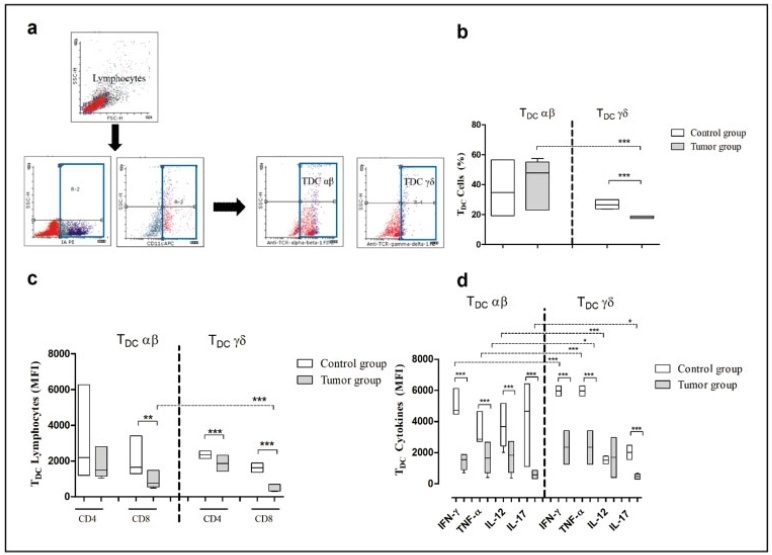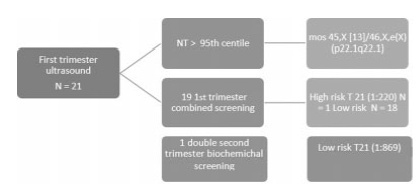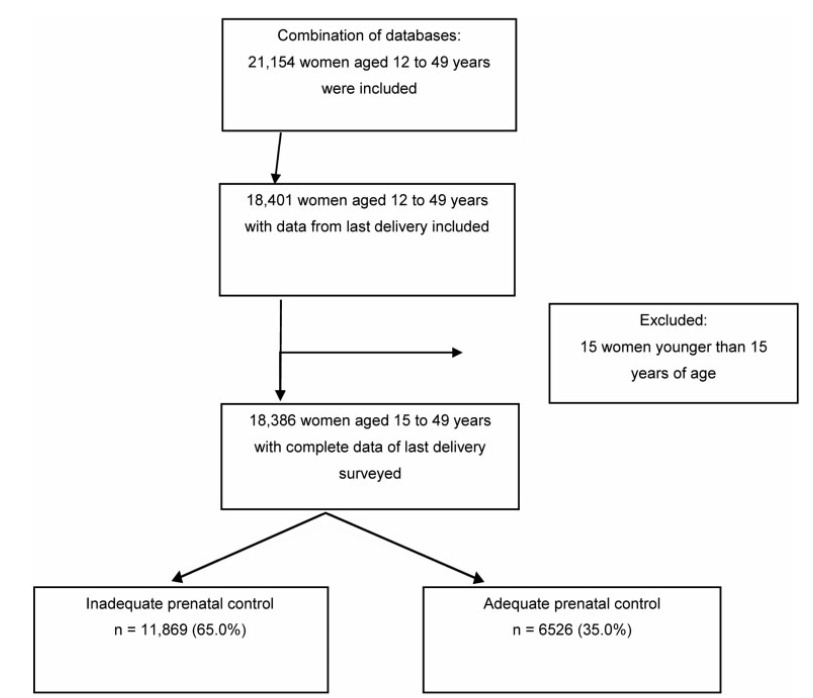Summary
Revista Brasileira de Ginecologia e Obstetrícia. 2021;43(5):368-373
To evaluate the antitumoral role of γδ TDC cells and αβ TDC cells in an experimental model of breast cancer.
Thirty female Balb/c mice were divided into 2 groups: control group (n=15) and induced-4T1 group (n=15), in which the mice received 2 x 105 4T1 mammary tumor cell line. Following the 28-day experimental period, immune cells were collected from the spleen and analyzed by flow cytometry for comparison of αβ TDC (TCRαβ+ CD11c+MHCII+) and γδ TDC (TCRγδ+CD11c+MHCII+) cells regarding surface markers (CD4+ and C8+) and cytokines (IFN-γ, TNF-α, IL-12 and IL-17).
A total of 26.53% of γδ TDC- control group (p<0.0001) - the proportion of αβ TDC was lower in splenic cells than γδ TDC; however, these 2 cell types were reduced in tumor conditions (p<0.0001), and the proportion of IFN-γ, TNF-α, IL-12 and IL-17 cytokines produced by γδ TDC was higher than those produced by αβ TDC, but it decreased under conditions of tumor-related immune system response (p<0.0001).
Healthy mice engrafted with malignant cells 4T1 breast tumor presented TDC with γδ TCR repertoire. These cells express cytotoxic molecules of lymphocytes T, producing anti-tumor proinflammatory cytokines.

Summary
Revista Brasileira de Ginecologia e Obstetrícia. 2021;43(5):362-367
The aim of the present study is to explain the barriers to puberty talk between mothers and daughters.
In the present study, the conventional content analysis method was used. The present study was conducted from September 2018 to August 2019 in Iran. The study population consisted of mothers and adolescent girls. The data was collected using purposeful sampling method. The sample consisted of 4 mothers and 6 girls that were interviewed using semistructured interviews. Data collection continued until data saturation was achieved. Data analysis was conducted as described by Graneheimet al. using NVivo 11 software.
In the present study, after exploring the views of the participants about barriers to puberty talk between mothers and daughters, one dominant theme emerged. Puberty talk is seen as an “inappropriate talk with a girl.” There were several subthemes, including “lack of mother’s awareness regarding the school role, the busy schedule of the mother, and the adoption of alternatives to mother’s talk with girls”.
Different sociocultural factors affect puberty talk between mothers and adolescent girls. It is important thatmothers and policymakers take these barriers intoaccount.
Summary
Revista Brasileira de Ginecologia e Obstetrícia. 2021;43(5):357-361
To study a sample of rheumatoid arthritis (RA) patients for their gynecological/obstetric history and compare them to controls to determine their influences on number of pregnancies, menarche, menopause and reproductive years following RA onset.
This is a cross-sectional study of 122 RA patients and 126 controls. Patients and controls were questioned about age of menarche, age of menopause, number of pregnancies and abortions. Reproductive years were calculated as the difference between age at menopause and age at menarche. For comparison, we used the Mann-Whitney, unpaired t, chi-squared, and Spearman tests. The adopted significance was 5%.
In the RA patients with disease beginning in the postmenopausal years, the period of reproductive years (age at menopause - age of menarche) showed a positive correlation with age at disease onset (rho=0.46; 95% confidence interval [CI]=0.20- 0.55 with p=0.0008). The number of pregnancies was higher in patients with postmenopausal disease onset when compared with those with premenopausal disease onset (median of 3 with interquartile range [IQR]=2-4 versus median of 2 with IQR=1-3; p=0.009), and RA patients had more pregnancies than controls (p=0.0002).
The present study shows that, in our population, the duration of reproductive years and the number of pregnancies are linked to the onset of RA.
Summary
Revista Brasileira de Ginecologia e Obstetrícia. 2021;43(5):351-356
Most prenatal screening programs for toxoplasmosis use immunoassays in serum samples of pregnant women. Few studies assess the accuracy of screening tests in dried blood spots, which are of easy collection, storage, and transportation. The goals of the present study are to determine the performance and evaluate the agreement between an immunoassay of dried blood spots and a reference test in the serum of pregnant women from a population-based prenatal screening program for toxoplasmosis in Brazil.
A cross-sectional study was performed to compare the immunoassays Imunoscreen Toxoplasmose IgM and Imunoscreen Toxoplasmose IgG (Mbiolog Diagnósticos, Ltda., Contagem, Minas Gerais, Brazil)in dried blood spots with the enzymelinked fluorescent assay (ELFA, BioMérieux S.A., Lyon, France) reference standard in the serum of pregnant women from Minas Gerais Congenital Toxoplasmosis Control Program.
The dried blood spot test was able to discriminate positive and negative results of pregnant women when comparedwith the reference test, with an accuracy of 98.2% for immunoglobulin G (IgG), and of 95.8% for immunoglobulin M (IgM).
Dried blood samples are easy to collect, store, and transport, and they have a good performance,making this a promisingmethod for prenatal toxoplasmosis screening programs in countries with continental dimensions, limited resources, and a high prevalence of toxoplasmosis, as is the case of Brazil.
Summary
Revista Brasileira de Ginecologia e Obstetrícia. 2021;43(6):467-473
To assess the sexual function of women with spina bifida (SB), and to verify the factors that influence their sexual function.
A cross-sectional study in which a validated female-specific questionnaire was applied to 140 SB female patients from four different cities (Porto Alegre, Brazil; and Barcelona, Madrid, and Málaga, Spain) between 2019 and 2020. The questionnaires collected data on the clinical characteristics of SB, and female sexual function was assessed using the 6-item version of the Female Sexual Function Index (FSFI-6) validated to Portuguese and Spanish.
Half of the patients had had sexual activity at least once in the life, but most (57.1%) did not use any contraception method. Sexual dysfunction was present in most (84.3%) patients, and all sexual function domains were impaired compared those of non-neurogenic women. The presence of urinary and fecal incontinence significantly affected the quality of their sexual activity based on the FSFI-6.
The specific clinical aspects of the SB patients, such as urinary and fecal incontinence, should be properly addressed by their doctors, since they are associated with reduced sexual activity and lower FSFI-6 scores in the overall or specific domains. There is also a need to improve gynecological care among sexually-active SB patients, since most do not use any contraceptive methods and are at risk of inadvertent pregnancy.

Summary
Revista Brasileira de Ginecologia e Obstetrícia. 2021;43(6):457-466
Abnormalities in the eutopic endometrium of women with endometriosis may be related to disease-associated infertility. Although previous RNA-sequencing analysis did not show differential expression in endometrial transcripts of endometriosis patients, other molecular alterations could impact protein synthesis and endometrial receptivity. Our aim was to screen for functional mutations in the transcripts of eutopic endometria of infertile women with endometriosis and controls during the implantation window.
Data from RNA-Sequencing of endometrial biopsies collected during the implantation window from 17 patients (6 infertile women with endometriosis, 6 infertile controls, 5 fertile controls) were analyzed for variant discovery and identification of functional mutations. A targeted study of the alterations found was performed to understand the data into disease’s context.
None of the variants identified was common to other samples within the same group, and no mutation was repeated among patients with endometriosis, infertile and fertile controls. In the endometriosis group, nine predicted deleterious mutations were identified, but only one was previously associated to a clinical condition with no endometrial impact. When crossing the mutated genes with the descriptors endometriosis and/or endometrium, the gene CMKLR1 was associated either with inflammatory response in endometriosis or with endometrial processes for pregnancy establishment.
Despite no pattern of mutation having been found, we ponder the small sample size and the analysis on RNA-sequencing data. Considering the purpose of the study of screening and the importance of the CMKLR1 gene on endometrial

Summary
Revista Brasileira de Ginecologia e Obstetrícia. 2021;43(6):452-456
The objective of the present study was to determine the frequency of malformations and chromosomal abnormalities in a population of fetuses with an aberrant right subclavian artery (ARSA).
This is a 6-year retrospective study of fetuses with a prenatal diagnosis of ARSA conducted during the period between September 2013 and June 2019 at a fetal medicine unit. Data were collected from ultrasound, fetal echocardiograms, genetic studies, and neonatal records.
An ARSA was diagnosed in 22 fetuses. An ARSA was an isolated finding in 18 out of 22 cases (82%). Associated abnormal sonographic findings were found in 4 cases. All cases underwent invasive testing. In 1 of the cases, a chromosomal abnormality was detected (mos 45,X [13]/46,X,e(X) (p22.1q22.1)). No cases of congenital heart disease were found in any of these fetuses. There were two cases in which the postnatal evaluation revealed amalformation: one case of hypospadias and 1 case of cleft palate.
The presence of an isolated ARSA is benign and is not associated with chromosomal abnormalities. The finding of ARSA, however, warrants a detailed fetal ultrasound in order to exclude major fetal abnormalities and other soft markers.

Summary
Revista Brasileira de Ginecologia e Obstetrícia. 2021;43(6):442-451
To determine the adequacy of compliance with antenatal care (ANC) by pregnant women in Peru and to identify the associated factors.
An analytical cross-sectional study of data from the 2019 Peruvian Demographic and Family Health Survey (Encuesta Demográfica y de Salud Familiar, ENDES, in Spanish) was conducted. The dependent variable was adequate compliance with ANC (provided by skilled health care professionals; first ANC visit during the first trimester of pregnancy; six or more ANC visits during pregnancy; ANC visits with appropriate content) by women aged 15 to 49 years in their last delivery within the five years prior to the survey. Crude and adjusted prevalence ratios and their 95% confidence intervals were calculated using a log-binomial regression model.
A total of 18,386 women were analyzed, 35.0% of whom adequately complied with ANC. The lowest proportion of compliance was found with the content of ANC (42.6%). Sociodemographic factors and those related to pregnancy, such as being in the age groups of 20 to 34 years and 35 to 49 years, havingsecondaryor higher education, belonging to a wealth quintile of the population other than the poorest, being from the Amazon region, not being of native ethnicity, having a second or third pregnancy, and having a desired pregnancy, increased the probability of presenting adequate compliance with ANC.
Only 3 out of 10women in Peru showed adequate compliancewith ANC. Compliance with the content of ANC must be improved, and strategies must be developed to increase the proportion of adequate compliance with ANC.
